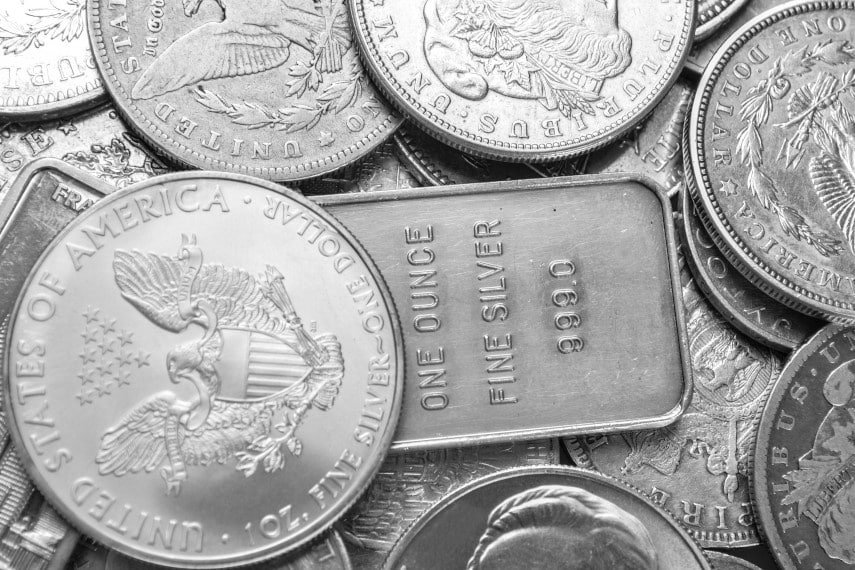Could Buying Gold Be a Good Retirement Plan?
With the recent unease in financial markets, more and more Americans are looking for safety when it comes to their assets Many people are starting to worry and are looking for alternatives, one of...
Precious Metals

With the recent weakness in the economy and desire on the part of many investors to protect their wealth, investment in precious metals has become more popular than it has been in a decade. One of the first questions investors decide on is whether to invest in gold or silver. While gold gets significantly more attention and press coverage than silver, silver has actually outperformed gold this year.
That’s not unusual, as during bull markets silver can often see greater price performance than gold. During the 2008-2011 bull market, silver nearly quadrupled in price, while gold “only” tripled. Investors in many asset classes would have been thrilled to get either of those price gains, and undoubtedly many would also be thrilled about the performance that gold and silver could see over the next few years.
Today, more and more investors are choosing to invest in silver. They’re looking to take advantage of the upside to silver, investing in a metal that has been undervalued for years, and that is overdue for a price breakout. But once they’ve made that decision to invest in silver, the question becomes: should I invest in silver coins or silver bars?
It’s not an unimportant question, as not all silver is created equal. And if you’re prepared to spend tens or hundreds of thousands of dollars on silver, you want to know that your investment will make you completely happy.
So what will it be? Silver bars or silver coins? Read on to find out the differences between silver bars vs. silver coins, and which form of silver investment makes the most sense for you.
One of the first things investors think about when trying to decide on silver bars vs. coins is what the differences are between the two. There are at least five that investors need to take into account.
The primary difference between silver coins and silver bars is that coins have or had a legal tender value, while bars do not. The legal tender of nearly all silver coins is far less than its metal value. For instance, the Silver American Eagle contains one ounce of pure silver, yet has a $1 face value. The Silver Canadian Maple Leaf also contains one ounce of silver, and its face value is CAD$5. And the Australian ½-ounce Silver Saltwater Crocodile has a face value of AUS$0.50.
Silver bars don’t have a legal tender face value, partially because in most cases they’re not produced or issued by government-owned mints, nor were they ever intended for circulation as money. They’ll normally contain some indication of their weight and purity, either on the bar itself or on its packaging.
It’s important to note a third alternative to silver coins vs. bars – silver rounds. Rounds are, as the name suggests, round silver planchets that are minted with various designs and are best described as a type of medal. Their designs may imitate designs of silver coins, but they’re not produced by government mints, nor do they have any legal tender face value, so for investment purposes it’s best to consider them as essentially a round bar.
In general, coins will be round and bars will be square or rectangular. That isn’t exclusive, as square coins exist, although none of the commonly available silver coins demanded by investors are square. And while bars are normally square or rectangular, silver rounds, which are perhaps better classified as a type of bar, are round.
One of the biggest differences between silver bars vs. coins is their size. Silver coins were most commonly available in sizes up to one ounce. In recent years, mints have started to produce silver coins for investors and collectors in sizes up to five ounces. But silver bars have always been available in much larger sizes.
Silver bars produced in troy ounce sizes generally range from 1 ounce up to 100 ounces, with industrial bars of 1,000 ounces available too. Metric bars are now available in sizes as small as 1 gram (0.032 troy ounces) up to 1 kilogram (about 161 ounces).
Because silver has been a monetary metal for millennia, silver coins have been minted for centuries, with a wide range of silver purity. Sterling silver (.925) was a common alloy for coinage in the UK, while the US and numerous other countries favored a .900 fine alloy. You’ll also come across coins in .800 fineness (Canada), .835 (Latin Monetary Union, Austria-Hungary), .625, and even .500.
It’s important to remember that if you intend to invest in silver coins through a silver IRA, they have to have a minimum fineness of .999, which means that only coins minted in the past 35 years or so, and intended for the investment market, are eligible for you to invest in. If you use your IRA assets to invest in coins that don’t meet that minimum fineness standard, it’s considered a distribution of your IRA’s assets, and could subject you to income taxes and penalties.
Silver bars, because they’re intended for investors from the outset, are normally minted to a fineness of .999 or higher, allowing investors to hold them in a silver IRA.
Silver coins offer a multiplicity of designs. From the classic Adolph Weinman Walking Liberty design of the Silver American Eagle to the changing reverse designs of the UK’s Silver Britannia Lunar Series, there’s a design out there for everyone. There are even limited edition coins minted to commemorate various occasions such as the end of World War I, coins that won’t be produced again once their supplies are sold out.
Silver bars sometimes feature a design, although in most cases they aren’t nearly as ornate as those on coins. Silver bars are often the choice of those looking purely to invest in silver without concern for the beauty or design of their investment assets.
One of the benefits of investing in silver bars is that they’re available in various sizes. For someone wanting to invest $50,000 in silver, that could be thousands of coins. But with large silver bars, that could mean investing in a single 1,000-ounce bar and several 100-ounce bars. That’s easier to store and keep track of.
Silver bars may be more affordable on a per-ounce basis, especially in the larger sizes. The downside there is that not every investor can afford to drop tens of thousands of dollars on a single silver bar.
Some silver bars also come with certificates of authenticity, serial numbers, and other means of preventing counterfeiting and fraud. That can help assuage the minds of investors worried about being defrauded of their hard-earned money.
One of the major benefits of silver coins is that they are easily recognizable. Everyone recognizes the coins produced by the US Mint, Royal Mint, Perth Mint, and others. But not every investor is familiar with the bars produced by refiners and assayers.
Silver coins can also be easier to transport than large bars. And because they’re smaller in size, in the event of a breakdown of the monetary system, they’re easier to use in commerce than silver bars. You may not think that the monetary system will break down anytime soon, but when currencies collapse, it often happens quickly and unexpectedly. Remember the Weimar hyperinflation in post-World War I Germany, in which those who owned gold and silver, or currencies that could be redeemed for gold and silver, fared better than those who held paper money, bank deposits, or pensions.
Some silver coins, especially those minted specifically for investment through a silver IRA, also come with certificates of authenticity in order to combat counterfeiting. And if you purchase those coins from sellers who deal directly with the mints who produced them, you’ll eliminate the possibility of buying counterfeit coins, a problem that can plague some secondary precious metals markets.
As with any other investment, the form of silver you purchase is dependent on your investing goals. If you’re looking only to benefit from the monetary gains that you could make from an increase in the silver price, and you don’t plan on ever taking physical delivery of your silver, then you might decide that silver bars are the better choice for you.
If you want to benefit monetarily from silver’s price gains but you also want to hedge against devaluation of the dollar or a collapse of the international fiat currency monetary system, and you think that you might decide to take some or all of your silver IRA distributions in the form of physical silver, then you may decide to invest in silver coins vs. silver bars.
Or then again, if you want to maximize your exposure to silver and diversify your silver investments, you could invest in both. A healthy mix of both silver coins and silver bars could be just what you need to rebalance your investments and position yourself to benefit from future price gains.
If you’re looking to invest in silver, it’s important to work with experts in the field who can help you achieve your investment aims. With years of experience helping investors benefit from investing in silver, the experts at Goldco will help you navigate the world of precious metals investing.
It isn’t just questions about silver bars vs. silver coins that they can help you with either. They can help you navigate every step of the process, from deciding to start a silver IRA, rolling over funds from existing retirement accounts, how to buy silver, and more. Don’t wait any longer to learn more about how silver can benefit your investments. Contact Goldco today to get started in silver investing.

